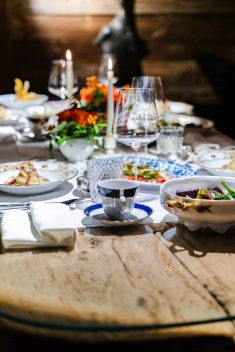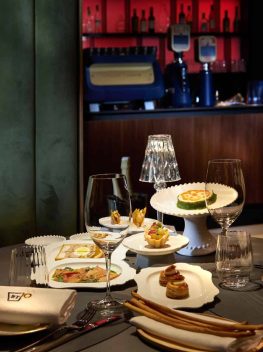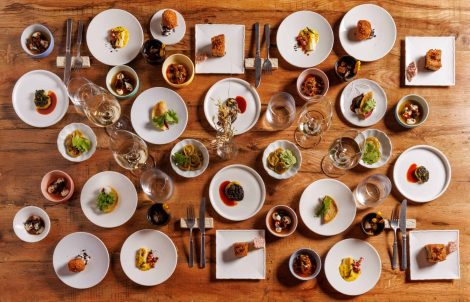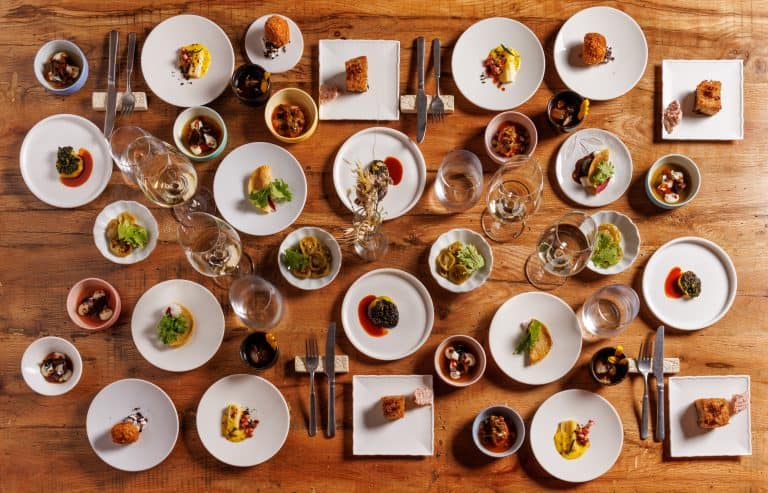The Appetizer is part of the (recent) culinary history of Italy as a whole. And although some trace its origins back to Roman times, more accredited theories speak of its spread starting from the 18th and 19th centuries. Alberto Grandi, associate professor of Food History at the University of Parma and author of the book "Denominazione di origine inventata: le bugie del marketing sui prodotti tipici italiani" published by Mondadori, which is now also a podcast, is convinced of this. He argues that before these dates, there was no conception of the appetizer as we understand it today because in the past all dishes were mixed on the table, without a specific order, an order imposed by French cuisine only in the 17th century. Thus, according to Grandi, it is to the French that the invention of the appetizer with that order in menus that open with hors d'oeuvres (appetizer precisely) is owed, which originated in the 17th century and strengthened in the following centuries. The Italian appetizer, on the other hand, can be traced back to the late 19th century: Pellegrino Artusi mentions it for the first time in his "La scienza in cucina e l'arte di mangiar bene" from 1891. A milestone in the history of Italian cuisine, this volume gathers 790 recipes, including those appetizers that he calls "principii" and identifies with oysters, cold cuts, tongue, anchovies, sardines, caviar served alone or accompanied by butter, but also with crostini paired with chicken livers to truffles.
The modern appetizer, as we understand it today, was born in the post-war period and strengthened, becoming a unique and identity-building tradition, in the different Italian regions. And today there is no restaurant on the Peninsula that does not offer it: whether it is fish, meat or vegetable, it doesn't matter, from giardiniera to zucchini in carpione, from Ciauscolo served with bread to seafood salad, it reigns supreme on Italian tables. Even in fine dining restaurants which, in recent months, have been enhancing it, replacing the single course with a plethora of dishes served all at once. Let's explore this new trend through the proposal of three restaurants and understand why.
Incö

The experience at the table of Incö in the weinstube of La Stüa de Michil, the starred restaurant led by the chef of Calabrian origin Simone Cantafio, is the work of Simone Cantafio (a student of Gualtiero Marchesi and right-hand man of the Bras family) in Alta Badia. We are in the heart of the Dolomites, inside the Hotel La Perla in Corvara, where on a table stripped of the most ceremonial side of the service of a starred restaurant, dishes that are an expression of territories and relationships between cuisine and farmers are proposed.
The table becomes a place of storytelling, conviviality, and identity, memory and welcome through a three-act journey that begins with the Italian appetizer followed by a shared course and desserts. Dishes that, nomen omen (Incö in Ladin means "today"), tell of the daily life of a product, of a raw material with which Simone Cantafio daily decides the menu to be offered in the evening, as mentioned by the Villnösser Brillenschaf, the sheep with glasses by Günther Pernthaler in Val di Funes, as well as honey, speck, pigs, turkeys, mountain salt, and an ancient variety of buckwheat. Or the snails that Andrea Facci and Lucia Perlot breed in Fai della Paganella or the farms of Hubert Comploi in La Valle (Bz). The appetizers here are served in six courses all placed on the table at the same time: it is the diners who serve themselves directly from the plates in front of them. Some examples? Cannelloni stuffed with shank and gratinated with black truffle, clear beef broth, Snails all'arrabbiata or even Sausage and fennel meatballs or Crostini with mountain liver pâté.
SanTommaso 10

The new restaurant of Lavazza has been open for almost a year in Turin in the place where, in 1895, Giuseppe Lavazza opened his grocery store which gave rise to the coffee empire now known worldwide. Gabriele Eusebi, a chef of Marche origins with experiences at La Madonnina del Pescatore with Moreno Cedroni, at Mugaritz by Luis Andoni Aduriz, or alongside Federico Zanasi from Condividere, the other Lavazza-signed restaurant in Turin, was called to lead the young brigade. The proposal of SanTommaso 10, since its opening, is aimed at paying homage to Italian cuisine by bringing to light flavors of tradition revised with techniques and tastes of contemporary cuisine. And the start of this endeavor is precisely with that Carousel of appetizers, served simultaneously on the table, which is already an icon of sharing.
"The inspiration comes from Italian cuisine of the 1980s," explains Eusebi, and thus dishes are born such as Carpaccio of ventresca with rocket and bottarga (which renews the historic Alba dish with rocket and grana cheese), the Crêpe Suzette of breed, cooked in butter, flavored with Aurum (a liqueur from Abruzzo) and served with orange sauce and orange zest. Or even that Russian salad which here visually transforms into a cassata to pay homage to the famous pastry chef from Noto, Corrado Assenza. "The appetizer," explains the chef, "is the first impression, the business card that one leaves. We decided, as is the style of the restaurant, to play on informality with honest and straightforward and tasty preparations, playful preparations that work on memories and focus on sharing. To do this, we return to the French menu, revisiting the past and adapting it to the needs of the present."
Ristorante Une

We are in Foligno (Pg), in the heart of the most authentic Umbria and here, Giulio Gigli has opened his Une, a restaurant that is a hymn of love that seems to be written specifically for this land. After years of experience abroad (among others Disfrutar, 1947 at Le Cheval Blanc, Benu, and Il Pagliaccio), Gigli returns home and creates a place with a very strong identity, aimed at enhancing local raw materials, but with a great eye towards the world. Wooden tables, minimal setting, orange and salmon color breaks reminiscent of the agricultural ones of the place tell of a welcoming environment surrounded by 5 thousand meters where there is a vegetable garden, a terrace, an outdoor kitchen, a small orchard, a wheat field to produce the flour needed for baking.
There are two tasting menus that both start with a great appetizer composed of four or five courses. "I like to think," explains Gigli, "that the beginning of our journey can recreate a convivial situation and, for many, help bring back memories like for me those Sunday family lunches where the first course was preceded by a table full of cold cuts, cheeses, sauces, vegetables. The appetizer reminds many people of festive moments and puts people at ease even in a restaurant."
Here is explained the gastronomic proposal of Gigli which starts with the classic welcome and continues with that Italian appetizer composed of several courses. At Une (which in Umbrian means water), numerous preserves are made throughout the year: this explains why the appetizer here always proposes them as in the case of the aglione flower preserve. But there are also red turnip leaves and potatoes with an aglione cream and wild rocket chimichurri; glazed veal tongue served with smoked black cabbage and hazelnut and black truffle hollandaise; pumpkin foam with timut pepper with toasted pumpkin seed pralines and sour cream. Clearly, everything depends on the course of the seasons and tells of a dynamic and fun proposal where, in the appetizer, wild herbs and flowers also play a central role.


 Farewell cacio e pepe in New York. "With tariffs, Pecorino Romano will also become more expensive." The warning from Giuseppe Di Martino
Farewell cacio e pepe in New York. "With tariffs, Pecorino Romano will also become more expensive." The warning from Giuseppe Di Martino Against tariffs? Here are the US foods that could be "hit"
Against tariffs? Here are the US foods that could be "hit" US tariffs: here are the Italian wines most at risk, from Pinot Grigio to Chianti Classico
US tariffs: here are the Italian wines most at risk, from Pinot Grigio to Chianti Classico "With U.S. tariffs, buffalo mozzarella will cost almost double. We're ruined." The outburst of an Italian chef in Miami
"With U.S. tariffs, buffalo mozzarella will cost almost double. We're ruined." The outburst of an Italian chef in Miami "With US tariffs, extremely high risk for Italian wine: strike deals with buyers immediately to absorb extra costs." UIV’s proposal
"With US tariffs, extremely high risk for Italian wine: strike deals with buyers immediately to absorb extra costs." UIV’s proposal






